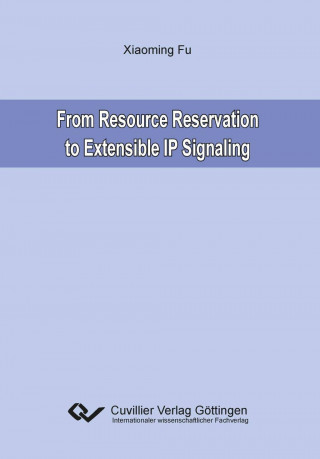
Kód: 12828513
From Resource Reservation to Extensible IP Signaling
Autor Xiaoming Fu
In recent years, the tremendous growth of the Internet and the increasing demand of user applications have resulted in a number of architectural changes to the Internet infrastructure. By its original, the Internet based on the pa ... celý popis
- Jazyk:
 Angličtina
Angličtina - Vazba: Brožovaná
- Počet stran: 172
Nakladatelství: Cuvillier Verlag, 2014
- Více informací o knize

Mohlo by se vám také líbit
-

You Can't Touch My Hair
385 Kč -

Myth and the Human Sciences
2078 Kč -

Fast Like a Girl
565 Kč -

Bugün Farkli Düsünüyorum
393 Kč -

Comment Faire L'Amour Toute La Nuit
646 Kč -

Antiterrordateigesetz
2149 Kč -

Entwicklung Durch Handel?
1225 Kč
Dárkový poukaz: Radost zaručena
- Darujte poukaz v libovolné hodnotě a my se postaráme o zbytek.
- Poukaz se vztahuje na celou naši nabídku.
- Elektronický poukaz vytisknete z e-mailu a můžete ihned darovat.
- Platnost poukazu je 12 měsíců od data vystavení.
Více informací o knize From Resource Reservation to Extensible IP Signaling
Nákupem získáte 81 bodů
 Anotace knihy
Anotace knihy
In recent years, the tremendous growth of the Internet and the increasing demand of user applications have resulted in a number of architectural changes to the Internet infrastructure. By its original, the Internet based on the packet-switched technology has been designed for delivering packets in a best effort fashion: the end systems do not need to inform the network prior to transmitting their IP packets, whole routers simply perform routing and forwarding of these packets without distinguishing from each other. However, this design has been challenged due to the new requirements which have been dramatically different from over 30 years ago. For example, to realize the bandwidth and connectivity on demand for the service providers, a signaling protocol seems to be critical. Signaling is not a new topic. In the telecommunication industry, signaling is common and can be dated back to when circuit switches first replaced human telephone operators. Even the modern Signaling System No. 7 (SS7) [187] began its development in the mid 1970's, based on the idea that relies on a separate control element (i.e., the SS6 signal switches) to signal to other control element to set up, manage and release voice trunk lines required to make a call. Based on the signaling standard for ISDN [8], ITU-T standardized a Q.2931 signaling protocol [9] which allows ATM nodes to exchange control of information, request the use of network resources, or negotiate for the use of circuit parameters, for instance, mapping between an input set and an output set of virtual circuit parameters, for instance, mapping between an input set and an output set of virtual circuit identifiers (VCIs) and virtual path identifiers (VPIs). Essentially, signaling protocols manages states in network nodes. They generally reflect some requirements of an end-to-end session/call to the traverses nodes. Thus, they need to be maintained properly, especially when network "conditions" change (e.g., some link or node fails, or the traversing route changes). The task of a signaling protocol involves establishing, maintaining and removing network control states, traversing from one end system to another through the network. Hence, the concept of signaling protocol discussed in this book mainly targets at network control state singnaling.
 Parametry knihy
Parametry knihy
809 Kč
- Plný název: From Resource Reservation to Extensible IP Signaling
- Autor: Xiaoming Fu
- Jazyk:
 Angličtina
Angličtina - Vazba: Brožovaná
- Počet stran: 172
- EAN: 9783954046010
- ISBN: 3954046016
- ID: 12828513
- Nakladatelství: Cuvillier Verlag
- Hmotnost: 231 g
- Rozměry: 210 × 148 × 9 mm
- Datum vydání: 07. March 2014
Oblíbené z jiného soudku
-

Dune
216 Kč -

Haunting Adeline
621 Kč -

Berserk Deluxe Volume 2
1092 Kč -

White Nights
90 Kč -

Powerless
291 Kč -

Atomic Habits
330 Kč -

Dune Messiah
228 Kč -

Berserk Deluxe Volume 3
1142 Kč -

One Day
221 Kč -

Berserk Deluxe Volume 1
1115 Kč -

Iron Flame
368 Kč -

Surrounded by Idiots
213 Kč -

Harry Potter and the Prisoner of Azkaban (Minalima Edition)
993 Kč -

Gravity Falls Journal 3
443 Kč -

Heaven Official's Blessing: Tian Guan Ci Fu (Novel) Vol. 1
440 Kč -

The Creative Act
568 Kč -

Dune
276 Kč -

Hunting Adeline
624 Kč -

A Little Life
291 Kč -

Children of Dune
230 Kč -

Heaven Official's Blessing: Tian Guan Ci Fu (Novel) Vol. 2
426 Kč -

Bungo Stray Dogs, Vol. 8 (light novel)
379 Kč -

Percy Jackson and the Olympians 5 Book Paperback Boxed Set
944 Kč -

Solo Leveling, Vol. 1
440 Kč -

The Prisoner's Throne
191 Kč -

Court of Thorns and Roses
268 Kč -

Cry Baby Coloring Book
276 Kč -

Fourth Wing
321 Kč -

Icebreaker
199 Kč -

Berserk Deluxe Volume 6
1089 Kč -

Avatar, the Last Airbender: The Kyoshi Novels (Box Set)
986 Kč -

The 48 Laws of Power
601 Kč -

House of Leaves
462 Kč -

Twisted Lies
213 Kč -

Dune Messiah
214 Kč -

No Longer Human
317 Kč -

48 Laws Of Power
331 Kč -

Twisted Games
213 Kč -

Caraval Paperback Boxed Set
902 Kč -

Solo Leveling, Vol. 2
437 Kč -

Open Circuits
907 Kč -

Berserk Deluxe Volume 5
1119 Kč -

Heaven Official's Blessing: Tian Guan Ci Fu (Novel) Vol. 3
414 Kč -

Berserk Deluxe Volume 4
1292 Kč -

Court of Mist and Fury
206 Kč -

SOLO LEVELING V08
436 Kč -

English File Upper Intermediate Multipack A (4th)
531 Kč -

CHAINSAW MAN V14
251 Kč -

Before the Coffee Gets Cold
184 Kč
Osobní odběr Praha, Brno a 12903 dalších
Copyright ©2008-24 nejlevnejsi-knihy.cz Všechna práva vyhrazenaSoukromíCookies



 Vrácení do měsíce
Vrácení do měsíce 571 999 099 (8-15.30h)
571 999 099 (8-15.30h)